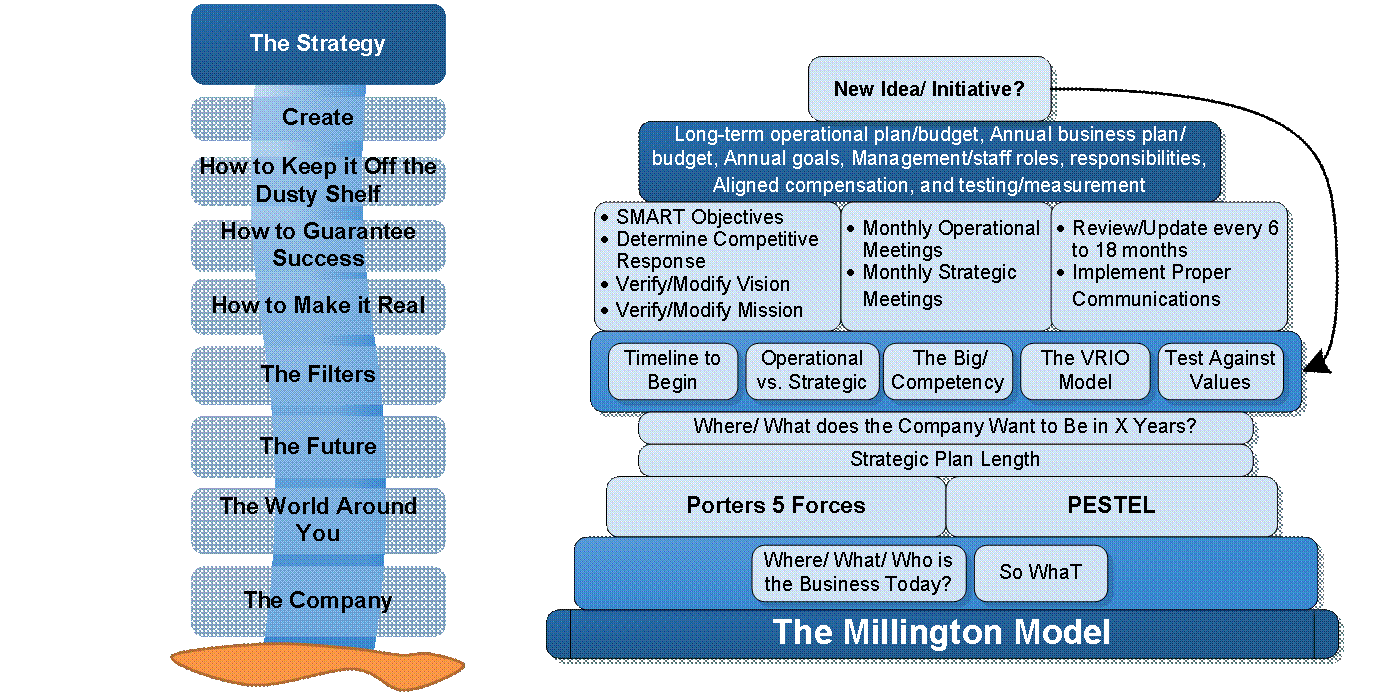“…Steve is a brilliant strategist…”
Strategic Facilitation
The Millington Model – Why it Works for Anyone!
Incorporating academic and industry best practices, the Millington Model has been developed and honed over 7 years through its use with over 90 clients. Easily remembered analogies guide you through a step-by-step approach that clarifies where you are today, evaluates the industry and issues that effect it, and then stimulates a dynamic exploration of where you want to be in X years. With each step in the process, the room will get 'smarter' and better equipped to develop a long-term plan. Various strategic analysis tools are used to ensure consensus, test, measure, and filter your ideas and goals that will shape the strategic direction of the firm. The end result is a path for the next 12-months that is aligned with your long-term goals, Mission, Vision and Values.
Our facilitators use the Millington Model for strategic planning; the model includes:

The Millington Model is comprised of four major steps.
Company Overview
The first steps are used to understand who or what the firm is today including core competencies, tangible and intangible assets, and competitive positioning.
- What do you want out of this strategy session?
- Where/who/what is the firm now?
- SO WhaT Strategic Analysis Tool
Industry Overview
After understanding the firm, the business environment is detailed and measured; knowing the industry influences the strategic direction of the firm.
- Porters 5 Forces Strategic Analysis Tool
- PEESTL Strategic Analysis Tool
Strategic Plan Development
Using the information gained about the firm and the environment, this stage pulls everything together. The strategic analysis tools are used as a funnel to refine and understand which of the firm's strategic objectives and goals are critical: offering either an operational efficiency or inimitable advantage.
- Where will the firm be in X years?
- Big/Easy Goals
- Operational vs. Strategic Goals
- VRIO Strategic Analysis tool
- Timeline of Goals
Strategy Implementation and Ownership
With the strategic goals outlined from previous stages, Steve can continue to add value through actively working with the firm to ensure the strategy is realized. Leveraging past experiences and expertise gained throughout the strategic retreat,
Steve and the Millington Model are in a prime position to lend best practices for strategy implementation and realization. Steve facilitates and actively collaborates with the firm to define goal ownership and develop detailed objectives to support implementing and realizing the strategy.
- Determine goal champions
- Create SMART objectives for each goal
Through a series of team and one-on-one meetings with goal champions, Steve ensures the SMART objectives and plan details are fully developed. After chairing the initial SMART objective committee meetings, Steve continues to be involved: supporting these champions and facilitating meetings, as required, to ensure the strategic plan is realized.
This continuously leads to tangible results and accomplishing strategic objectives for the firm as the end product of the Millington Model.
What's Next?
From the Millington Model, the strategic plan forms the foundation for the firm. With universal agreement on where the firm wants to go and how they will get there, the next steps include:
Updating and ensuring the Vision, Mission, and Values are linked to the new direction of the firm
- Divisional strategic plans
- Long term operational plansAnnual business plan and budget
- CEO and staff objectives and measures
- Board structure, committees, and their deliverables
- Structure, tasks, and deliverables; testing and measurement
The strategic plan should be reviewed at least once per year, but ideally, addressed at each Board meeting.
Testimonials
"Steve Howse was able to get us to think more clearly and focus our thoughts like never before. We left our strategic session raring to go!"
- Mike Carnegie, Partner, Taylor Liebow
